
The London Underground as air raid shelters in World War Two
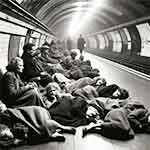
In spite of its name, the London Underground is not all underground. Where it was, the station platforms, corridors, off-rooms and even escalators provided safe shelter from air raids in the Second World War. This page describes the sleeping arrangements which were uncomfortable, foul smelling and dangerous. It brings them to life with firsthand recollections.
____
By the webmaster: her early recollections and further research with contributions from others who experienced these shelters at the time
Why the London Underground for air raid shelters
Not all the lines of the London Underground were actually underground, but those that were provided safe shelter from the bombs of the German air raids. Parts of the corridors and spaces were filled with bunk beds and people without shelters at home were allocated tickets to use them overnight. There were never enough of these, so the overflow were allowed to sleep on the platforms, in the corridors and even perched on the escalator treads once the power was turned off in the late evening.
Sleeping on the station platforms in the blitz of WW2
As a young child in the early 1940s, I clearly remember the underground tube journeys with both my parents, late in the evenings. (My father must have been home on leave, or maybe it was before he was called up for the army.) What struck me was the mass of humanity sitting and lying down on the station platforms, set up with their mattresses and blankets, ready for going to sleep for the night.
I asked my parents if we could sleep on the platforms too, because to me - as a child - it looked like fun. But they always said no. I think they felt that if they were going to die, they would rather do it in their own home.
Conditions on the platforms and escalators where people slept
Once the platforms were full, the overflow actually slept on the corridor floors and escalators which of course were turned off for the night. It must have been incredibly uncomfortable, but the people who did it presumably did so because it was the only way they could be sure to wake up alive the next morning.
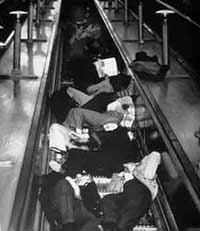
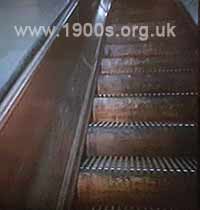
Escalators had wide wooden slats for treads which would have been warmer than today's stainless steel but almost impossible to clean.
According to one of my cousins, the conditions on station platforms were horrendous. Her mother travelled up to the City of London and back every day and often remarked on the dreadful stench of all those people bedded down together for the night. The station lavatories were not designed to cope with anything other than the needs of the occasional passenger, and no-one would move from their patch anyway for fear of someone else taking it. So there were a good number of open chamber pots - or worse.
More about the unpleasantness of underground station platforms as air raid shelters
As I looked down [from the steps] at the eastbound platform, my heart sank. There [seemed to be] thousands of them: hordes of jabbering people, mostly in brown or grey coats. They looked like a great mass of cockroaches spread out on the floor in front of me. Just to breathe, I had to concentrate.
[Apart from the safety from bombs] tube platforms were hazardous, packed with people in all states and conditions. Afraid and starved of daylight, some of them down there can be funny about their 'pitches' on the platform. I heard stories about women effing and blinding at each other, fights blocking exits, blood on the platforms and everything else.
from 'Last Rights' by Barbara Nadel
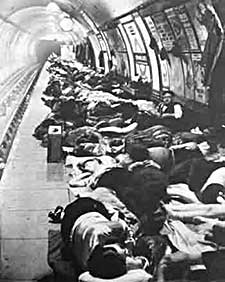
People taking shelter from bombs on a platform. Photo in the effects of my aunt, Ena Cole.
Safety of young children on Underground platforms
My family were caught in London during an air raid and found ourselves spending the night sheltering on a London Underground platform. There were other young children like ourselves running about, getting told off, and told to come and sit down. It wasn't safe for them because the trains were still running, but what else could anyone do?
Then one very old lady with a very broad Cockney Accent came to the rescue. "You leave the children to me, my dear," she told my mother. "I will sort them out for you."
She took us up to the end of the platform where the trains came out, and one at a time she held us so that we could lean well over and look up into the tunnel. Then she asked us what we could see. We said we could see some lights shining.
"Ahrr" she replied in that Cockney accent, "What you could see were giant fleas eyes shining in the dark. If you go too near the tunnel at either end of the platform, these giant fleas may come out and get you. They are as big as horses."
We never left mother's side again.
Stan Clark
Allocated spaces for bunk beds in London Underground shelters
What I hadn't realised until years later when I started studying the old films of the time and talking to people older than myself who used to live in London was that the passages connecting the various platforms of the London Underground were officially air raid shelters, with bunk-style beds.
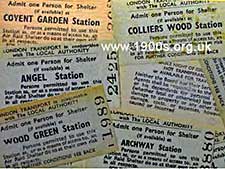
Tickets for using the London Underground to shelter from bombs in the blitz of WW2, detail from a picture in the London Transport Museum.
There were tickets to use these spaces which was in contrast to the platforms where it was first-come first-served.
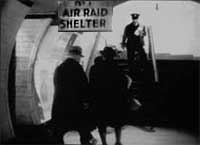
Sign to No 1 Air Raid Shelter in the London Underground
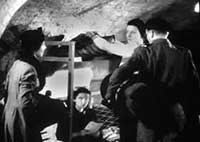
Bunk beds in the shelter
Screen shots from old films
The refreshment train
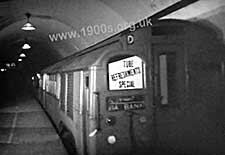
A refreshment train for the people sheltering overnight
Neither had I realised until much later that the people bedded down for the night on the Underground were serviced by a special refreshment train. I wonder what sort of refreshments they were and whether customers had to produce a ration book for them.
The rails must have been alive in order for the train to move which must have made it both necessary and stressful to have to keep young children away from the edge of platforms.
Text and images are copyright
sources: early 20th century material
sources: ww2 home front and other material
contact
the webmaster/author/researcher/editor
privacy policy
















